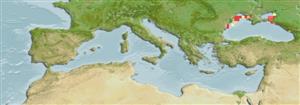>
Clupeiformes (Herrings) >
Alosidae (Shads and Sardines)
Etymology: Alosa: Latin, alausa = a fish cited by Ausonius and Latin, halec = pickle, dealing with the Greek word hals = salt; it is also the old Saxon name for shad = "alli" ; 1591 (Ref. 45335).
Environment: milieu / climate zone / depth range / distribution range
Sinh thái học
Biển; Nước ngọt; Thuộc về nước lợ; di cư biển sông (để đẻ trứng) (Ref. 51243). Temperate; 48°N - 37°N, 27°E - 54°E
Eurasia: Black Sea, Sea of Azov and Caspian Sea.
Bộ gần gũi / Khối lượng (Trọng lượng) / Age
Maturity: Lm ? range ? - ? cm
Max length : 32.0 cm TL con đực/không giới tính; (Ref. 593); common length : 20.0 cm SL con đực/không giới tính; (Ref. 188); Khối lượng cực đại được công bố: 250.00 g (Ref. 593); Tuổi cực đại được báo cáo: 7 các năm (Ref. 10549)
Các tia vây lưng cứng (tổng cộng) : 0; Tia cứng vây hậu môn: 0. Body `shad-like', usually rather deep and compressed. Total gill rakers 50 to 180, long and thin, distinctly longer than filaments. Teeth poorly developed in jaws, sometimes barely detectable. A black spot posterior to gill opening and occasionally further black spots on flank in some cases.
Schooling and migratory (Ref. 188); at sea, pelagic in coastal waters with steady current and avoids areas with stable salinity; migrates from sea to mouth of large rives and spawns in fresh- or slightly brackish-water at shallow sites washed by flow of large rivers. Males migrate upriver at 2-3 years, females at 4-5; many individuals reproduce 2-4 seasons. Two migration peaks, one in late April (mostly males), one in early May (mostly females), entering rivers when temperature rises above 10°C. Spawns when temperature is at least 15°C, in May to June. Spawning usually occurs in the upper 3 m. Eggs semi-pelagic and demersal. Spent fish migrate back to the sea; juveniles migrate to sea during first summer, remaining there until they mature. Feeds mainly on zooplankton (copepods and mysids) when at sea (Ref. 59043). Depending on the subspecies (10 subspecies known), some are semi-anadromous and spawn in fresh or slightly saline waters, mainly in the lower reaches, whereas others are practically marine and spawn in brackish or even fully saline oceanic waters. One of the most warm-loving Alosa of the Caspian. Only A. a. caspia of the Caspian Sea is of commercial importance (Ref. 188).
Depending on the subspecies some are semi-anadromous and spawn in fresh or slightly saline waters, mainly in the lower reaches, whereas others are practically marine and spawn in brackish or even fully saline oceanic waters (Ref.188).There are two migration peaks, one in late April (mostly males) and one in early May (mostly females). Spent fish migrate back to sea. Juveniles migrate to sea during first summer, remaining at sea until they mature (Ref. 59043).
Whitehead, P.J.P., 1985. FAO Species Catalogue. Vol. 7. Clupeoid fishes of the world (suborder Clupeoidei). An annotated and illustrated catalogue of the herrings, sardines, pilchards, sprats, shads, anchovies and wolf-herrings. FAO Fish. Synop. 125(7/1):1-303. Rome: FAO. (Ref. 188)
IUCN Red List Status (Ref. 130435: Version 2024-2)
Threat to humans
Harmless
Human uses
Các nghề cá: tính thương mại cao
Các công cụ
Special reports
Download XML
Các nguồn internet
Estimates based on models
Phylogenetic diversity index (Ref.
82804): PD
50 = 0.5000 [Uniqueness, from 0.5 = low to 2.0 = high].
Bayesian length-weight: a=0.00692 (0.00572 - 0.00837), b=3.09 (3.05 - 3.13), in cm total length, based on LWR estimates for this species (Ref.
93245).
Mức dinh dưỡng (Ref.
69278): 3.5 ±0.46 se; based on food items.
Generation time: 3.7 ( na - na) years. Estimated as median ln(3)/K based on 1
growth studies.
Thích nghi nhanh (Ref.
120179): Trung bình, thời gian nhân đôi của chủng quần tối thiểu là 1.4 - 4.4 năm (tmax=7).
Fishing Vulnerability (Ref.
59153): Low to moderate vulnerability (34 of 100).
Nutrients (Ref.
124155): Calcium = 16.7 [7.1, 87.1] mg/100g; Iron = 0.673 [0.290, 1.421] mg/100g; Protein = 19.1 [16.5, 21.8] %; Omega3 = 1.43 [0.76, 2.77] g/100g; Selenium = 10.4 [5.1, 20.6] μg/100g; VitaminA = 29.1 [7.3, 113.9] μg/100g; Zinc = 0.372 [0.231, 0.630] mg/100g (wet weight);
